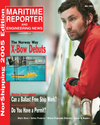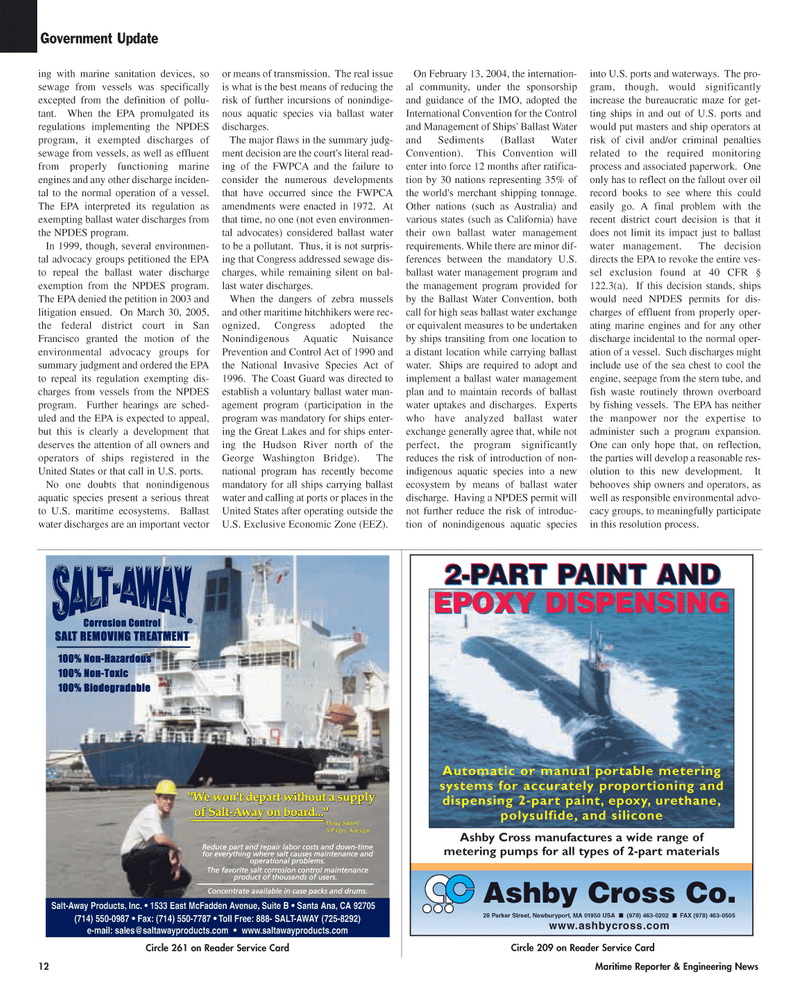
Page 12: of Maritime Reporter Magazine (May 2005)
Marine Enviroment Edition
Read this page in Pdf, Flash or Html5 edition of May 2005 Maritime Reporter Magazine
12 Maritime Reporter & Engineering News ing with marine sanitation devices, so sewage from vessels was specifically excepted from the definition of pollu- tant. When the EPA promulgated its regulations implementing the NPDES program, it exempted discharges of sewage from vessels, as well as effluent from properly functioning marine engines and any other discharge inciden- tal to the normal operation of a vessel.
The EPA interpreted its regulation as exempting ballast water discharges from the NPDES program.
In 1999, though, several environmen- tal advocacy groups petitioned the EPA to repeal the ballast water discharge exemption from the NPDES program.
The EPA denied the petition in 2003 and litigation ensued. On March 30, 2005, the federal district court in San
Francisco granted the motion of the environmental advocacy groups for summary judgment and ordered the EPA to repeal its regulation exempting dis- charges from vessels from the NPDES program. Further hearings are sched- uled and the EPA is expected to appeal, but this is clearly a development that deserves the attention of all owners and operators of ships registered in the
United States or that call in U.S. ports.
No one doubts that nonindigenous aquatic species present a serious threat to U.S. maritime ecosystems. Ballast water discharges are an important vector or means of transmission. The real issue is what is the best means of reducing the risk of further incursions of nonindige- nous aquatic species via ballast water discharges.
The major flaws in the summary judg- ment decision are the court's literal read- ing of the FWPCA and the failure to consider the numerous developments that have occurred since the FWPCA amendments were enacted in 1972. At that time, no one (not even environmen- tal advocates) considered ballast water to be a pollutant. Thus, it is not surpris- ing that Congress addressed sewage dis- charges, while remaining silent on bal- last water discharges.
When the dangers of zebra mussels and other maritime hitchhikers were rec- ognized, Congress adopted the
Nonindigenous Aquatic Nuisance
Prevention and Control Act of 1990 and the National Invasive Species Act of 1996. The Coast Guard was directed to establish a voluntary ballast water man- agement program (participation in the program was mandatory for ships enter- ing the Great Lakes and for ships enter- ing the Hudson River north of the
George Washington Bridge). The national program has recently become mandatory for all ships carrying ballast water and calling at ports or places in the
United States after operating outside the
U.S. Exclusive Economic Zone (EEZ).
On February 13, 2004, the internation- al community, under the sponsorship and guidance of the IMO, adopted the
International Convention for the Control and Management of Ships' Ballast Water and Sediments (Ballast Water
Convention). This Convention will enter into force 12 months after ratifica- tion by 30 nations representing 35% of the world's merchant shipping tonnage.
Other nations (such as Australia) and various states (such as California) have their own ballast water management requirements. While there are minor dif- ferences between the mandatory U.S. ballast water management program and the management program provided for by the Ballast Water Convention, both call for high seas ballast water exchange or equivalent measures to be undertaken by ships transiting from one location to a distant location while carrying ballast water. Ships are required to adopt and implement a ballast water management plan and to maintain records of ballast water uptakes and discharges. Experts who have analyzed ballast water exchange generally agree that, while not perfect, the program significantly reduces the risk of introduction of non- indigenous aquatic species into a new ecosystem by means of ballast water discharge. Having a NPDES permit will not further reduce the risk of introduc- tion of nonindigenous aquatic species into U.S. ports and waterways. The pro- gram, though, would significantly increase the bureaucratic maze for get- ting ships in and out of U.S. ports and would put masters and ship operators at risk of civil and/or criminal penalties related to the required monitoring process and associated paperwork. One only has to reflect on the fallout over oil record books to see where this could easily go. A final problem with the recent district court decision is that it does not limit its impact just to ballast water management. The decision directs the EPA to revoke the entire ves- sel exclusion found at 40 CFR § 122.3(a). If this decision stands, ships would need NPDES permits for dis- charges of effluent from properly oper- ating marine engines and for any other discharge incidental to the normal oper- ation of a vessel. Such discharges might include use of the sea chest to cool the engine, seepage from the stern tube, and fish waste routinely thrown overboard by fishing vessels. The EPA has neither the manpower nor the expertise to administer such a program expansion.
One can only hope that, on reflection, the parties will develop a reasonable res- olution to this new development. It behooves ship owners and operators, as well as responsible environmental advo- cacy groups, to meaningfully participate in this resolution process.
Salt-Away Products,Inc.•1533 East McFadden Avenue,Suite B •Santa Ana,CA 92705 (714) 550-0987 • Fax: (714) 550-7787 • Toll Free: 888- SALT-AWAY (725-8292) e-mail: [email protected] • www.saltawayproducts.com
Circle 261 on Reader Service Card Circle 209 on Reader Service Card 2-PART PAINT AND
EPOXY DISPENSING
Ashby Cross Co. 28 Parker Street, Newburyport, MA 01950 USA ¦ (978) 463-0202 ¦ FAX (978) 463-0505 www.ashbycross.com
Automatic or manual portable metering systems for accurately proportioning and dispensing 2-part paint, epoxy, urethane, polysulfide, and silicone
Ashby Cross manufactures a wide range of metering pumps for all types of 2-part materials
Government Update
MR MAY 2005 #2 (9-16).qxd 5/3/2005 12:11 PM Page 4

 11
11

 13
13
